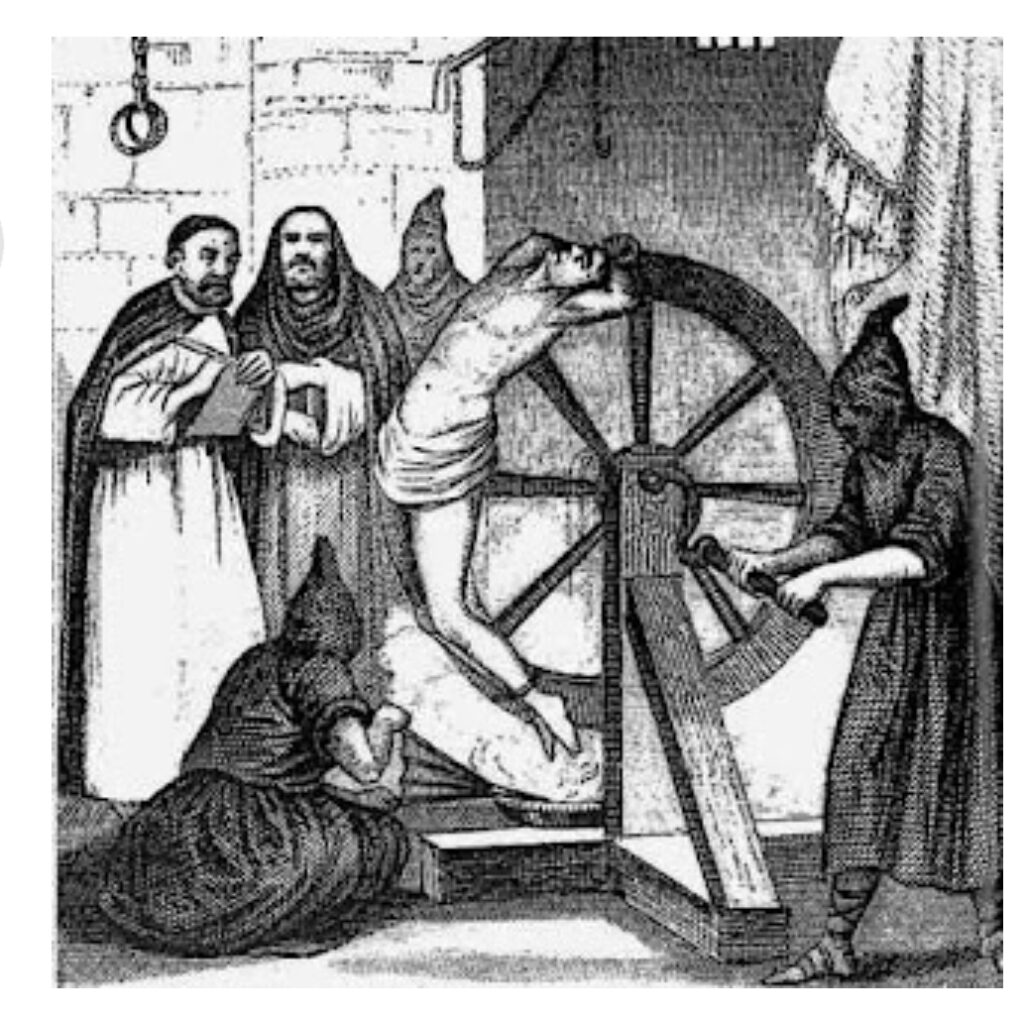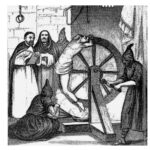
The breaking wheel or execution wheel, also known as the Wheel of Catherine or simply the Wheel, was a torture method used for public execution primarily in Europe from antiquity through the Middle Ages into the early modern period by breaking the bones of a criminal or bludgeoning them to death.
The practice was abolished in Bavaria in 1813 and in the Electorate of Hesse in 1836: the last known execution by the “Wheel” took place in Prussia in 1841. In the Holy Roman Empire it was a “mirror punishment” for highwaymen and street thieves, and was set out in the Sachsenspiegel for murder, and arson that resulted in fatalities.

Those convicted as murderers, rapists, traitors and or robbers to be executed by the wheel, sometimes termed to be “wheeled” or “broken on the wheel”, would be taken to a public stage scaffold site and tied to the floor.
The execution wheel was typically a large wooden spoked wheel, the same as was used on wooden transport carts and carriages (often with iron rim), sometimes purposely modified with a rectangular iron thrust attached and extending blade-like from part of the rim.
The primary goal of the first act was the agonizing mutilation of the body, not death. Therefore, the most common form would start with breaking the leg bones. To this end, the executioner dropped the execution wheel on the shinbones of the convicted person and then worked his way up to the arms.
Here, rhythm and number of beatings were prescribed in each case, sometimes also the number of spokes on the wheel. To increase its effect, often sharp-edged timbers were placed under the convict’s joints. Later, there were devices in which the convicted person could be “harnessed”.
Although not commonplace, the executioner could be instructed to execute the convicted person at the end of the first act, by aiming for the neck or heart in a “coup de grace”. Even less often, this occurred immediately from the start (from the head down).
In the second act, the body was braided into another wooden spoked wheel, which was possible through the broken limbs, or tied to the wheel. The wheel was then erected on a mast or pole, like a crucifixion.
After this, the executioner was permitted to decapitate or garrotte the convicted if need be. Alternatively, fire was kindled under the wheel, or the “wheeled” convict was simply thrown into a fire. Occasionally, a small gallows was set up on the wheel, for example, if there were a guilty verdict for theft in addition to murder.
Since the body remained on the wheel after execution, left to scavenging animals, birds and decay, this form of punishment, like the ancient crucifixion, had a sacral function beyond death: according to the belief at that time, this would hinder transition from death to resurrection.
If the convict fell from the wheel still alive or the execution failed in some other way, such as the wheel itself breaking or falling from its placement, it was interpreted as God’s intervention. There exist votive images of saved victims of the wheel, and there is literature on how best to treat such sustained injuries.
The survival time after being “wheeled” or “broken” could be extensive. Accounts exist of a 14th-century murderer who remained conscious for three days after undergoing the punishment. In 1348, during the time of the Black Death, a Jewish man named Bona Dies underwent the punishment.
The authorities stated he remained conscious for four days and nights afterwards. In 1581, the possibly fictitious German serial killer Christman Genipperteinga remained conscious for nine days on the breaking wheel before expiring, having been deliberately kept alive with “strong drink”.
Alternatively, the condemned were spreadeagled and broken on a saltire, a cross consisting of two wooden beams nailed in an “X” shape, after which the victim’s mangled body might be displayed on the wheel.
We Hope That You Have Enjoyed Reading Our Blog On The World History And Facts. If You Enjoy This Blog Please Let Us Know In The Comments Below. If You Are Interested In History, We Recommend You Check Out Our Other Blogs Here On The World History And Facts. Thank You For Reading.










Leave a Reply